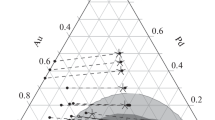Abstract
For random, diluted, multicomponent solutions, the excess chemical potentials can be expanded in power series of the composition, with coefficients that are pressure- and temperature-dependent. For a binary system, this approach is equivalent to using polynomial truncated expansions, such as the Redlich-Kister series for describing integral thermodynamic quantities. For ternary systems, an equivalent expansion of the excess chemical potentials clearly justifies the inclusion of ternary interaction parameters, which arise naturally in the form of correction terms in higher-order power expansions. To demonstrate this, we carry out truncated polynomial expansions of the excess chemical potential up to the sixth power of the composition variables.
Similar content being viewed by others
References
C. Wagner, Thermodynamics of alloys (Addison-Wesley, Reading, 1952)
L. S. Darken, Trans. Metall. Soc. AIME. 239, 90 (1967)
A. D. Pelton, C. W. Bale, Met. Trans. A 17, 1211 (1986)
C. W. Bale, A. D. Pelton, Met. Trans. A 1990, 21 (1997)
D. V. Malakhov, Calphad. 41, 16 (2013)
H. L. Lukas, S. G. Fries, B. Sundman, Computational thermodynamics: the Calphad method (Cambridge University Press, Cambridge, 2007)
M. Hillert, Calphad. 4, 1 (1980)
A. D. Pelton, C. W. Bale, Met. Mater. Trans. A 17, 1057 (1986)
A. D. Pelton, Met. Mater. Trans. B 28, 869 (1997)
D. V. Malakhov, Calphad. 35, 142 (2011)
Y. Chang, S. Chen, F. Zhang, X. Yan, F. Xie, R. Schmid-Fetzer, W. Oates, Progr. Mat. Sci. 49, 313 (2004)
O. Redlich, A. T. Kister, Ind. Eng. Chem. 40, 345 (1948)
N. A. Gokcen, J. Phase Equilib. 15, 147 (1994)
M. Margules, Sitzb AkadWissWienMath Naturw Kl II 104, 1243 (1895)
K. Wohl, T. Am. Inst. Chem. Eng. 42, 215 (1946)
E. A. Guggenheim, T. Faraday Soc. 33, 151 (1937)
W. Cheng, J. Ganguly, Geochim. Cosmochim. Ac. 58, 3763 (1994)
I. Ansara, Pure Appl. Chem. 70, 449 (1998)
M. Hillert, J. Phase Equilib. 16, 7 (1995)
N. A. Gokcen, J. Phase Equilib. 16, 8 (1995)
L. Eleno, J. Balun, G. Inden, C. G. Schön, Intermetallics 15, 1248 (2007)
W. A. Oates, H. Wenzl, Scripta Mater. 35, 623 (1996)
J. Tomiska, Calphad. 8, 283 (1984)
J. Tomiska, Calphad. 10, 91 (1986)
J. Tomiska, Calphad. 10, 239 (1986)
Y.-M. Muggianu, M. Gambino, J.-P. Bros, J. Chim. Phys. PCB. 72, 83 (1975)
D. N. Saulov, Calphad. 32, 608 (2008)
N. A. Gokcen, M. R. Baren, Met. Trans. A 16, 907 (1985)
N. A. Gokcen, Z. Moser, J. Phase Equilib. 14, 288 (1993)
G. Helffrich, B. Wood, Am. Miner. 74, 1016 (1989)
D. Saulov, Calphad 30, 405 (2006)
A. Janz, R. Schmid-Fetzer, Calphad 29, 37 (2005)
P. Chartrand, A. D. Pelton, J. Phase Equilib. 21, 141 (2000)
L. S. Darken, Trans. Metall. Soc. AIME. 239, 80 (1967)
Acknowledgments
This work has been financially supported by the São Paulo State Research Funding Agency (FAPESP, São Paulo, SP, Brazil) under Procs. 2009/14532-9 and 2012/04023-2, and by the Brazilian National Research Council (CNPq) under Proc. 304445/2010-0.
Author information
Authors and Affiliations
Corresponding author
Appendix: Proof of (5)
Appendix: Proof of (5)
Equation 5 is but a generalization of the expansion proposed by [1], who presented only the first few terms. The proof of the general expression, using the Gibbs-Duhem equation, may be of some interest. To that end, we write (3) in the following form
which is valid for a binary system A−B. More compactly, (4) can be rewritten as follows:
Substitution of the right-hand sides in (A2) for the excess chemical potentials in (A1) yields the equality
From (A3), we deduce immediately that Ω A,1= Ω B,1=0, as pointed out by Darken [34]. We also have to equate the sums within the parentheses on both sides of (A3). Division of both sides by the product x A x B then yields the expression
We now recall that x B =1−x A and use the binomial theorem to expand the resulting powers of 1−x A , which leads to the equality
Since the right-hand side of (A5) is a polynomial in x A , we can easily reverse the order of the double sum, to find that
The formal transformations λ→η−2 and η→λ adjusts the power of x A in the summand on the right-hand side of (A6) to make it identical to the power in the summand on the left-hand side:
since (−1)η−2=(−1)η.
Comparison between the coefficients of \(x_{A}^{\eta -2}\) in the summands on both sides of (A7) then yields the final result
Rights and permissions
About this article
Cite this article
Eleno, L.T.F., Schön, C.G. Ternary Interaction Parameters in Calphad Solution Models. Braz J Phys 44, 208–214 (2014). https://doi.org/10.1007/s13538-014-0183-0
Received:
Published:
Issue Date:
DOI: https://doi.org/10.1007/s13538-014-0183-0



